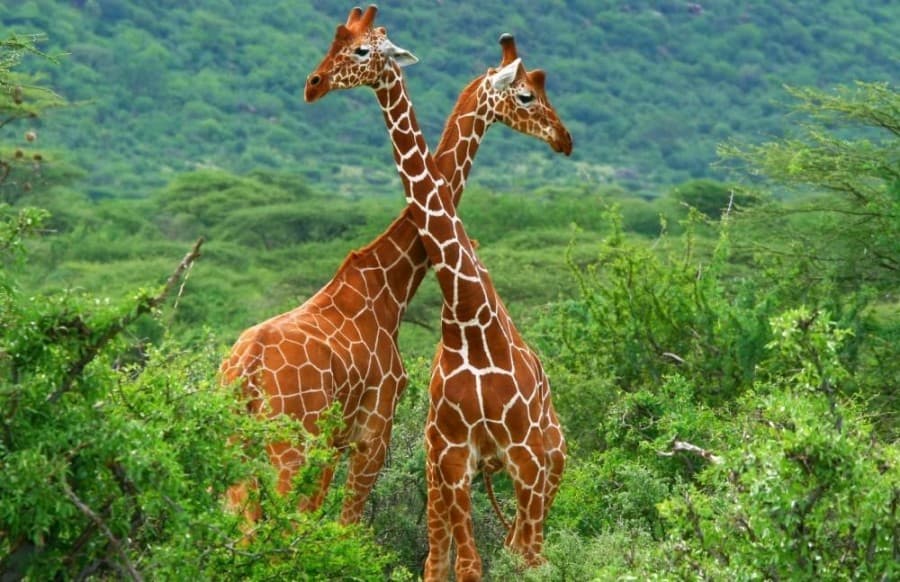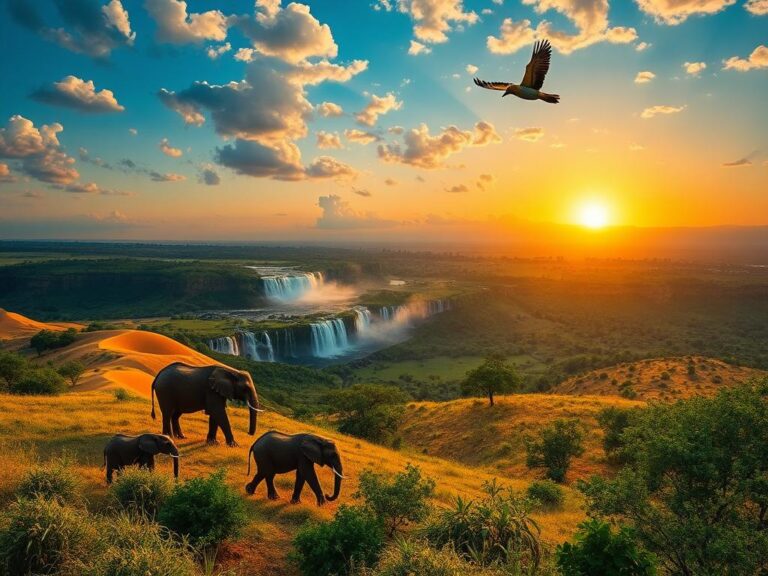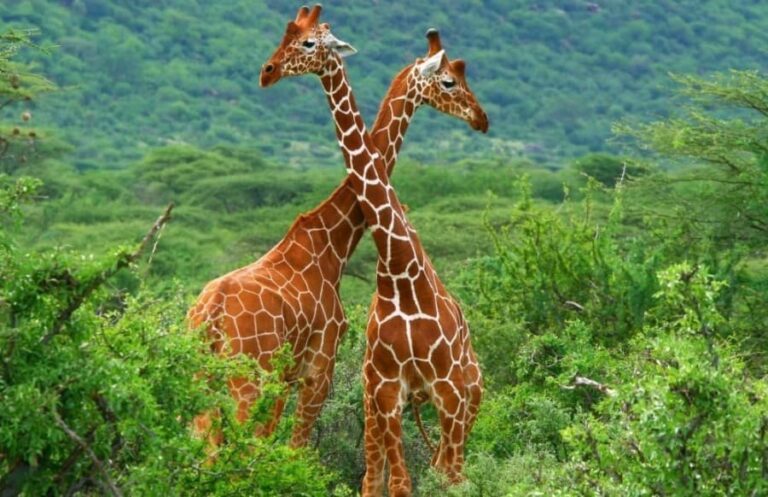
Best Safari Locations in Africa: A Journey Through Wildlife Wonders
Best safari locations in Africa offer an unforgettable experience for wildlife enthusiasts and adventure seekers alike.
African safari experiences are enchanting and unparalleled in thrilling wildlife diversity.
This article will guide you through the best safari locations across the continent, revealing the magic behind each destination and the unique wildlife that calls it home.
From the Great Migration in Maasai Mara to the serene waters of the Okavango Delta, every location has something distinct to offer.
Let’s dive into this incredible world of safari adventures!
1. Maasai Mara National Reserve, Kenya
Maasai Mara National Reserve is renowned for its sheer wildlife diversity.
This reserve is a spectacular setting for nature lovers, especially during the Great Migration from July to October.
Imagine hundreds of thousands of wildebeest migrating across vast plains, pursued by predators like lions and leopards.
The chance to witness such raw and dramatic scenes of nature is enough to give any adventurer goosebumps.
As you traverse the plains, you might also encounter elephants, cheetahs, and more than 450 species of birds.
The experience is not just about wildlife viewing; the landscape itself is a breathtaking blend of rich savannah, acacia woodlands, and riverine forests.
Visiting Maasai Mara is akin to stepping into a National Geographic documentary; you absorb the culture of the Maasai people while marveling at nature’s magnificence.
The best time to visit is during the migration period, but don’t overlook the months outside this timeframe, as the wildlife diversity is stunning year-round!
2. Serengeti National Park, Tanzania
Next on our journey is the Serengeti National Park, another gem for safari-goers.
Famed for its extensive savannas, the Serengeti’s wildlife spectacle is unlike anything else on earth.
Here, you can witness the epic migration of wildebeests and zebras, and the magnificent lions resting in acacia trees.
The park covers over 5,700 square miles of stunning landscapes, ranging from open plains to kopjes and riverine forests, teeming with wildlife.
Did you know that the Serengeti is home to about 3 million large mammals?
This rich biodiversity offers an unforgettable safari experience perfect for photographers and nature lovers alike.
Moreover, Serengeti National Park is a UNESCO World Heritage Site, recognized for its significance in preserving ecological and biological diversity.
Whether it’s hot air balloon safaris at sunrise or guided weekly trails, the options are plentiful.
3. Kruger National Park, South Africa
Third on our list is the iconic Kruger National Park, one of Africa’s largest game reserves.
Spanning nearly 7,600 square miles, it’s home to the infamous Big Five: lions, leopards, elephants, rhinos, and buffalo.
Kruger offers a mix of self-drive and guided safari experiences, giving visitors flexibility in how they explore the park.
The scenery ranges from open savannahs to lush bushveld, providing varying habitats for an incredible range of wildlife.
What makes Kruger unique is the extensive network of roads and rest camps allowing for accessibility and comfort during your safari adventure.
Tracking wildlife on foot with trained guides offers an intimate experience, providing insights into animal behavior and ecology.
Different seasons bring unique attributes; for instance, the dry winter months (May to September) provide excellent game viewing as animals gather around waterholes.
4. Chobe National Park, Botswana
Chobe National Park is celebrated for its extraordinary elephant population and breathtaking riverfront landscapes.
Located in northern Botswana, Chobe features diverse ecosystems that range from floodplains, wetlands, to rich woodlands.
Riverfront game viewing is magnificent, especially during the dry months when animals converge at the Chobe River to drink.
One fact that stands out is that Chobe is home to an estimated 120,000 elephants, making it one of the world’s largest concentrations.
Experience thrilling boat safaris gliding through the river, offering potentially close encounters with hippos, crocodiles, and birdlife.
Visitors can also delve into cultural interactions with the local San people and experience traditional handicrafts.
Chobe is a must-visit for those serious about wildlife photography or aiming to witness nature’s wonders up close!
5. Etosha National Park, Namibia
Etosha National Park is a unique safari destination characterized by its vast salt pans and exceptional wildlife.
The park offers incredible game viewing opportunities, with animals that include elephants, lions, and a thriving population of endangered black rhinos.
The beauty of Etosha lies not only in its diverse wildlife but also in the unique landscape; the shimmering salt flats create a mystical backdrop for safaris.
One of the great joys is the network of waterholes dotted throughout the park.
These serve as natural gathering spots for wildlife, particularly after sunset, providing excellent opportunities for night-time safari drives.
Etosha is home to more than 340 bird species, making it a birdwatcher’s paradise.
For convenience, several rest camps within the park provide facilities ranging from camping to luxury lodges; they make for perfect bases to explore the park!
6. Okavango Delta, Botswana
The Okavango Delta is a UNESCO World Heritage Site and a picturesque sanctuary for unique wildlife.
Known for its lush greenery and intricate waterways, this oasis offers visitors an extraordinary experience.
The Delta is famous for its mokoro (traditional canoe) safaris, allowing for quiet exploration of the waterways and close encounters with wildlife.
This area hosts rich flora and fauna, including elephants, hippos, and over 400 bird species, making it a haven for birdwatchers.
The best time to visit is during the flooding period from May to September, when the wildlife congregates in search of food.
Within the delta, privacy is often a priority, with many exclusive lodges situated in private concessions, offering a remote safari experience.
Adventurers looking to experience a true wilderness retreat will find rewards in the serene, tranquil ambiance of the Okavango.
7. Ngorongoro Crater, Tanzania
The Ngorongoro Crater is one of the most remarkable geological features on Earth.
This volcanic caldera, characterized by its dramatic landscape, is a UNESCO World Heritage site home to an abundance of wildlife.
Leading animal species here include lions, elephants, and the endangered black rhino.
The role of the crater as a natural enclosure fosters high wildlife density, making it a prime location for viewing these magnificent animals.
The stunning scenery enclosing the crater creates a natural amphitheater, enabling guests to enjoy remarkable panoramas.
Good accessibility makes Ngorongoro very popular with visitors; multiple lodges are situated on the rim, all offering striking views of the crater.
As one of the Seven Natural Wonders of Africa, it’s not hard to see why Ngorongoro is often considered a highlight for safari-goers!
8. Addo Elephant National Park, South Africa
Addo Elephant National Park is home to over 600 elephants, making it a fantastic safari destination.
This park’s diverse ecosystems provide a glimpse into different wildlife habitats, ranging from dense bush to coastal areas.
Visitors can expect to see many individuals from the Big Five, including buffalo, lions, and black rhinos.
For those who are interested in birdwatching, Addo also supports more than 400 bird species!
The park has evolved significantly since its establishment, now being one of South Africa’s prominent wildlife protectors.
Addo offers various safari options including self-drive, guided drives, and even horse riding safaris!
Given its anti-poaching programs, Addo stands out as a beacon of hope for wildlife conservation efforts.
9. Bwindi Impenetrable National Park, Uganda
Bwindi Impenetrable National Park is world-renowned for being home to nearly half of the world’s remaining mountain gorillas.
This UNESCO World Heritage site presents visitors with the unparalleled opportunity to trek through dense forest and observe these magnificent creatures.
The challenging hikes through hilly terrain and forests are not only an adrenaline rush but also deeply rewarding as you witness gorillas in their natural habitat.
The park houses rich biodiversity, including numerous bird species, butterflies, and other wildlife.
For visitors wishing for a truly unique safari experience, the gorilla trekking permit process ensures limited numbers to protect the species.
Bwindi is also a project for wildlife preservation and eco-tourism education, making this safari both memorable and ethically responsible.
10. Zambezi National Park, Zambia
Zambezi National Park is a hidden gem near Victoria Falls, offering a blend of breathtaking landscapes and thrilling safari adventures.
It serves as a fantastic starting point for experiencing the iconic falls while also offering fantastic wildlife sightings.
Walking safaris provide an intimate setting to explore the park and its unique ecosystems teeming with wildlife like elephants and hippos.
Zambezi National Park boasts a significant range, with opportunities for canoe safaris along the Zambezi River.
Beyond the wildlife, the scenic views of the sweeping landscapes and the spectacular falls only add to the experience.
Consider combining your visit to Zambezi with a tour of Victoria Falls for the ultimate adventure!
Conclusion
In the grand tapestry of African safari experiences, the best safari locations in Africa promise adventure, wonder, and unforgettable connections with nature.
As we traverse through the Maasai Mara, Serengeti, Kruger, Chobe, and many others, the diversity of wildlife and landscapes create a rich experience inviting everyone to partake.
Whether you’re an adventure seeker or simply hoping to witness nature’s beauty, each destination provides unique ways to engage with the wild.
So pack your gear, book your tickets, and immerse yourself in the vast wilderness that only Africa can offer!
FAQ
What is the best time to go on safari in Africa?
The best time to go on safari generally depends on the specific location and the wildlife you want to see. Most places have a peak season during the dry months, while others, like the Maasai Mara, host the annual migration from July to October, creating unique opportunities for witnessing wildlife movements.
Do I need vaccinations to go on safari in Africa?
Vaccinations are required or recommended depending on the countries you will be visiting. Always consult with a healthcare professional regarding necessary vaccinations for your trip. Common vaccinations include Hepatitis A, Typhoid, and Yellow Fever, especially if traveling to rural areas.
Are safaris safe?
Yes, safaris are generally safe when conducted with reputable tour guides. Always follow the rules and regulations set by the park and listen to your guide’s instructions for an enjoyable and safe experience.
What to pack for a safari?
When packing for a safari, consider lightweight clothing in neutral colors, binoculars, a good camera, sunscreen, insect repellent, and any personal medications. Comfortable footwear for walking is also essential.
Is it possible to do a budget safari in Africa?
Yes, budget safaris are available through various tour operators, focusing on camping and lower-cost accommodations. Self-drive safaris can also be more economical. Research and plan ahead to find the best options within your budget!
Share your thoughts, experiences, or questions about your safari adventures in the comments below!


